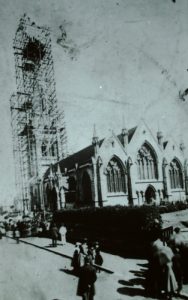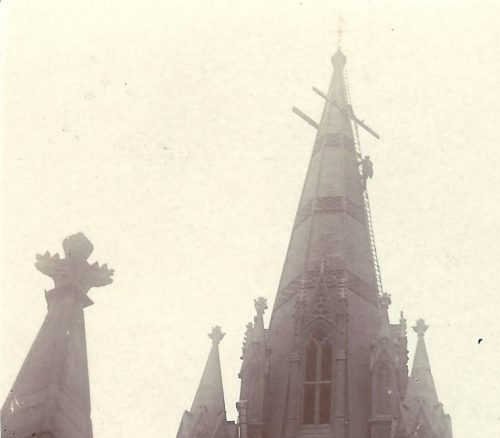Ryde Architecture
THE SPIRE
All Saints’ Parish Church, Ryde

Building the Spire 1882
In March 1882, it was said that All Saints’ Parish Church which had so long been tower-less and spire-less, would very shortly have this reproach removed. The spire was almost complete, and could be seen very conspicuously from the water. There could be no question that All Saints’ was the handsomest sacred edifice in Ryde. It was understood that £1,000 was still needed for the church completion fund.
June 1882 brought about the completion of the Spire. It was built by Mr. Isaac Barton, local contractor, and cost £3,037. The tower was built of Swanage stone and the spire was of Best box, ground Bath stone, terminating with a cap of solid Portland stone.
Just thirty years later, the Rev. Hugh Le Fleming, speaking at the Easter Vestry meeting in April 1912, said “that a curious trouble beset them in the collapse of the Church Spire. That was a matter which caused the greatest interest at the time, owing to the curious antics of the steeplejack employed in putting it right.”
In speaking on the situation of finance, The Rev. Fleming also said “although it was such a new church, they did not know which part would go next.
No one would have thought that the spire would collapse. No one would have thought that a church only 40-years old would require every single tile on the three roofs to be replaced, which had actually happened.” A donor who must remain anonymous said “you need not bother about raising funds for the repair of the spire, you may consider it settled.”
Note:
In the Isle of Wight Observer 24 September 1921, it gave an account of a steeplejack at work during the past week, when some interesting work was taking place at the spire of All Saints’ Parish Church. Mr. W. Larkins, the well-known steeplejack of London being engaged to remove dangerous pinnacles. A ladder ran up the whole length of one side and ropes on the other, and the steeplejack went about his work with great dexterity. The high wind did not deter him in the least. A few years before, the church spire was repaired by Mr. Larkins father who subsequently met with a fatal accident whilst repairing a factory chimney.
Source: Hampshire Telegraph 8 March 1882, & IW Observer June 1882
Images: Roy Brinton Collection
Article: Ann Barrett

